FNSACC501 - Assessment 2: Financial and Business Performance Report
VerifiedAdded on 2020/11/12
|17
|3816
|184
Report
AI Summary
This report, a solution to FNSACC501 Assessment 2, delves into providing financial and business performance information. It covers various aspects, including the treatment of business expenses under tax legislation, allowances for businesses managed by trusts, and the concept of forecast returns. The report also analyzes adherence to financial policies by Not-for-Profit (NFP) organizations, repayment amounts, and business performance objectives. It explores the concept of General Purpose Financial Report Users (GPFRU), state and territory charges, and tax calculations on land. Furthermore, it examines practices for businesses paying Commonwealth taxes, financial information sought by clients, and different financial options. The report includes variance analysis of forecast returns, a quarterly financial management questionnaire, and file notes addressing financial issues. It also discusses the role of a financial manager in preparing Business Activity Statements (BAS) and assessing Goods and Services Tax (GST).
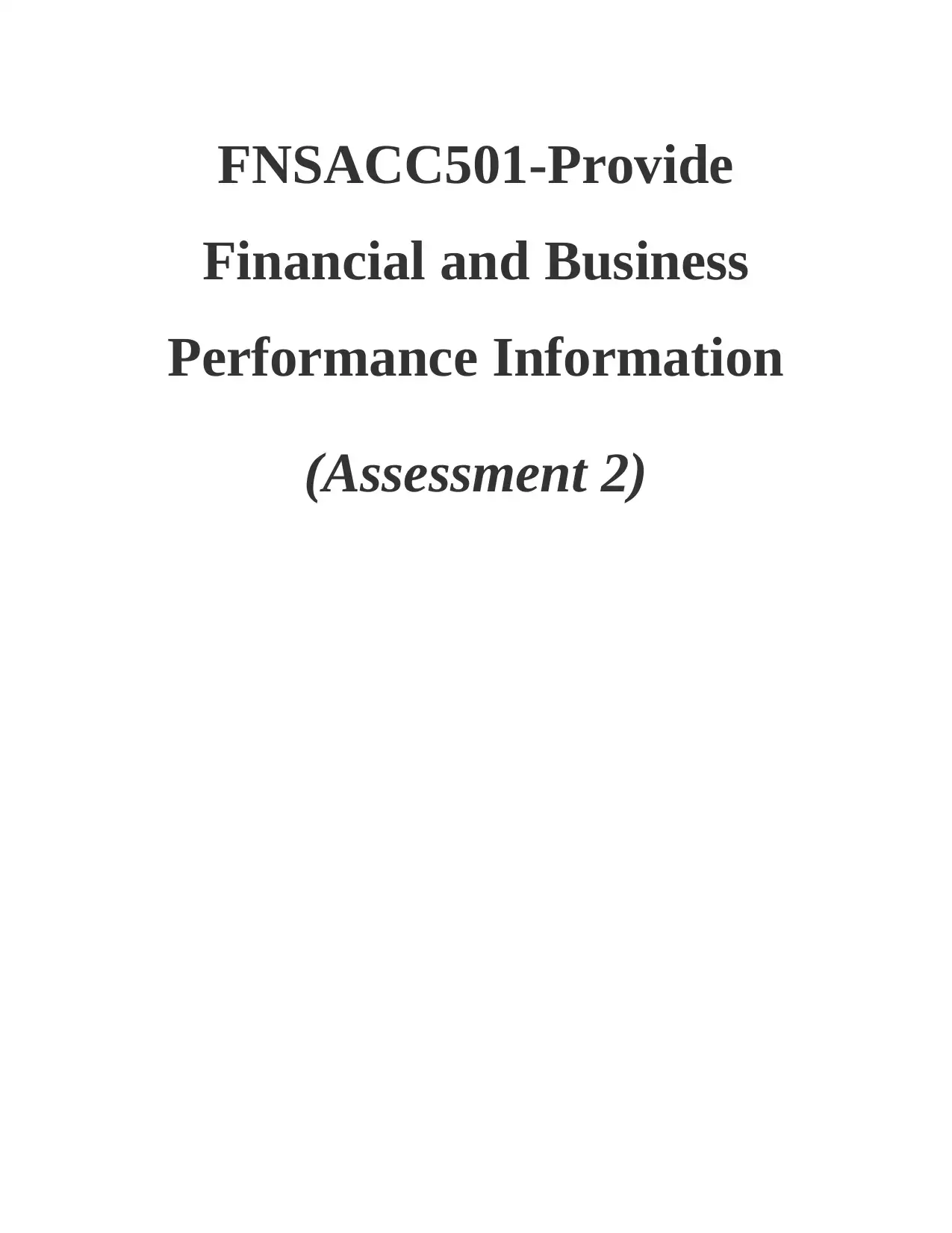
FNSACC501-Provide
Financial and Business
Performance Information
(Assessment 2)
Financial and Business
Performance Information
(Assessment 2)
Paraphrase This Document
Need a fresh take? Get an instant paraphrase of this document with our AI Paraphraser
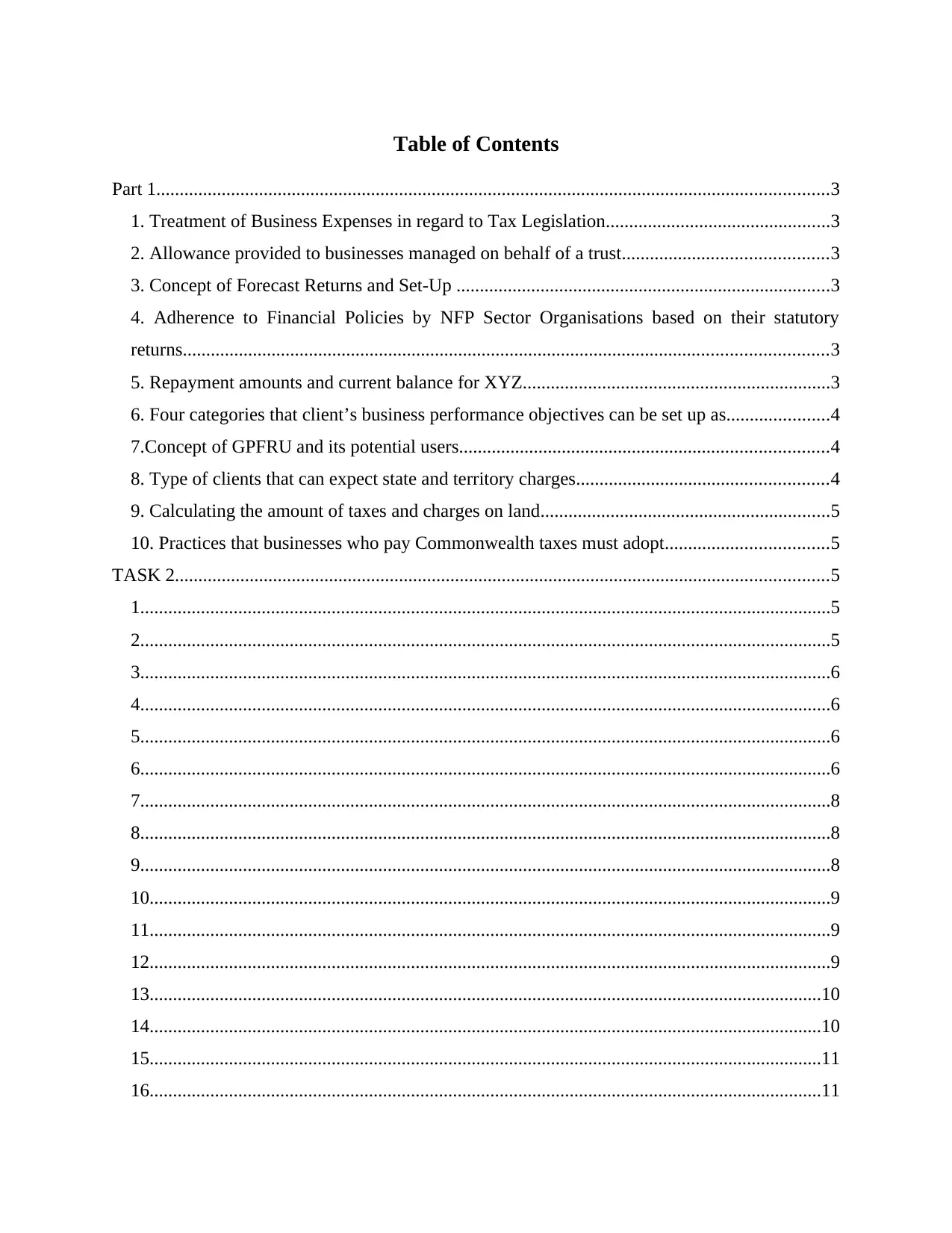
Table of Contents
Part 1................................................................................................................................................3
1. Treatment of Business Expenses in regard to Tax Legislation................................................3
2. Allowance provided to businesses managed on behalf of a trust............................................3
3. Concept of Forecast Returns and Set-Up ................................................................................3
4. Adherence to Financial Policies by NFP Sector Organisations based on their statutory
returns..........................................................................................................................................3
5. Repayment amounts and current balance for XYZ..................................................................3
6. Four categories that client’s business performance objectives can be set up as......................4
7.Concept of GPFRU and its potential users...............................................................................4
8. Type of clients that can expect state and territory charges......................................................4
9. Calculating the amount of taxes and charges on land..............................................................5
10. Practices that businesses who pay Commonwealth taxes must adopt...................................5
TASK 2............................................................................................................................................5
1....................................................................................................................................................5
2....................................................................................................................................................5
3....................................................................................................................................................6
4....................................................................................................................................................6
5....................................................................................................................................................6
6....................................................................................................................................................6
7....................................................................................................................................................8
8....................................................................................................................................................8
9....................................................................................................................................................8
10..................................................................................................................................................9
11..................................................................................................................................................9
12..................................................................................................................................................9
13................................................................................................................................................10
14................................................................................................................................................10
15................................................................................................................................................11
16................................................................................................................................................11
Part 1................................................................................................................................................3
1. Treatment of Business Expenses in regard to Tax Legislation................................................3
2. Allowance provided to businesses managed on behalf of a trust............................................3
3. Concept of Forecast Returns and Set-Up ................................................................................3
4. Adherence to Financial Policies by NFP Sector Organisations based on their statutory
returns..........................................................................................................................................3
5. Repayment amounts and current balance for XYZ..................................................................3
6. Four categories that client’s business performance objectives can be set up as......................4
7.Concept of GPFRU and its potential users...............................................................................4
8. Type of clients that can expect state and territory charges......................................................4
9. Calculating the amount of taxes and charges on land..............................................................5
10. Practices that businesses who pay Commonwealth taxes must adopt...................................5
TASK 2............................................................................................................................................5
1....................................................................................................................................................5
2....................................................................................................................................................5
3....................................................................................................................................................6
4....................................................................................................................................................6
5....................................................................................................................................................6
6....................................................................................................................................................6
7....................................................................................................................................................8
8....................................................................................................................................................8
9....................................................................................................................................................8
10..................................................................................................................................................9
11..................................................................................................................................................9
12..................................................................................................................................................9
13................................................................................................................................................10
14................................................................................................................................................10
15................................................................................................................................................11
16................................................................................................................................................11

17................................................................................................................................................11
18................................................................................................................................................12
19................................................................................................................................................12
20................................................................................................................................................13
21................................................................................................................................................13
REFERENCES..............................................................................................................................14
18................................................................................................................................................12
19................................................................................................................................................12
20................................................................................................................................................13
21................................................................................................................................................13
REFERENCES..............................................................................................................................14
⊘ This is a preview!⊘
Do you want full access?
Subscribe today to unlock all pages.

Trusted by 1+ million students worldwide
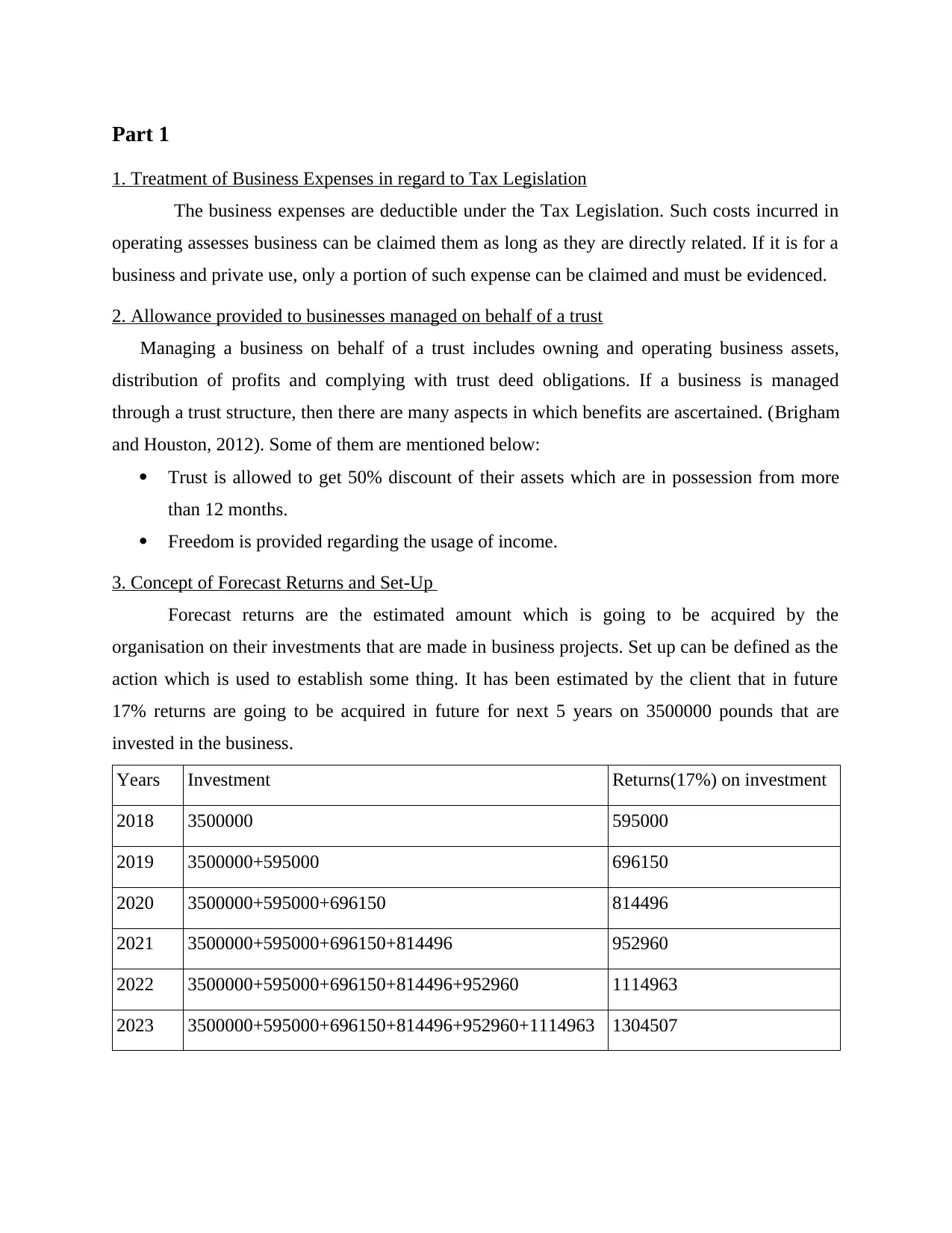
Part 1
1. Treatment of Business Expenses in regard to Tax Legislation
The business expenses are deductible under the Tax Legislation. Such costs incurred in
operating assesses business can be claimed them as long as they are directly related. If it is for a
business and private use, only a portion of such expense can be claimed and must be evidenced.
2. Allowance provided to businesses managed on behalf of a trust
Managing a business on behalf of a trust includes owning and operating business assets,
distribution of profits and complying with trust deed obligations. If a business is managed
through a trust structure, then there are many aspects in which benefits are ascertained. (Brigham
and Houston, 2012). Some of them are mentioned below:
Trust is allowed to get 50% discount of their assets which are in possession from more
than 12 months.
Freedom is provided regarding the usage of income.
3. Concept of Forecast Returns and Set-Up
Forecast returns are the estimated amount which is going to be acquired by the
organisation on their investments that are made in business projects. Set up can be defined as the
action which is used to establish some thing. It has been estimated by the client that in future
17% returns are going to be acquired in future for next 5 years on 3500000 pounds that are
invested in the business.
Years Investment Returns(17%) on investment
2018 3500000 595000
2019 3500000+595000 696150
2020 3500000+595000+696150 814496
2021 3500000+595000+696150+814496 952960
2022 3500000+595000+696150+814496+952960 1114963
2023 3500000+595000+696150+814496+952960+1114963 1304507
1. Treatment of Business Expenses in regard to Tax Legislation
The business expenses are deductible under the Tax Legislation. Such costs incurred in
operating assesses business can be claimed them as long as they are directly related. If it is for a
business and private use, only a portion of such expense can be claimed and must be evidenced.
2. Allowance provided to businesses managed on behalf of a trust
Managing a business on behalf of a trust includes owning and operating business assets,
distribution of profits and complying with trust deed obligations. If a business is managed
through a trust structure, then there are many aspects in which benefits are ascertained. (Brigham
and Houston, 2012). Some of them are mentioned below:
Trust is allowed to get 50% discount of their assets which are in possession from more
than 12 months.
Freedom is provided regarding the usage of income.
3. Concept of Forecast Returns and Set-Up
Forecast returns are the estimated amount which is going to be acquired by the
organisation on their investments that are made in business projects. Set up can be defined as the
action which is used to establish some thing. It has been estimated by the client that in future
17% returns are going to be acquired in future for next 5 years on 3500000 pounds that are
invested in the business.
Years Investment Returns(17%) on investment
2018 3500000 595000
2019 3500000+595000 696150
2020 3500000+595000+696150 814496
2021 3500000+595000+696150+814496 952960
2022 3500000+595000+696150+814496+952960 1114963
2023 3500000+595000+696150+814496+952960+1114963 1304507
Paraphrase This Document
Need a fresh take? Get an instant paraphrase of this document with our AI Paraphraser
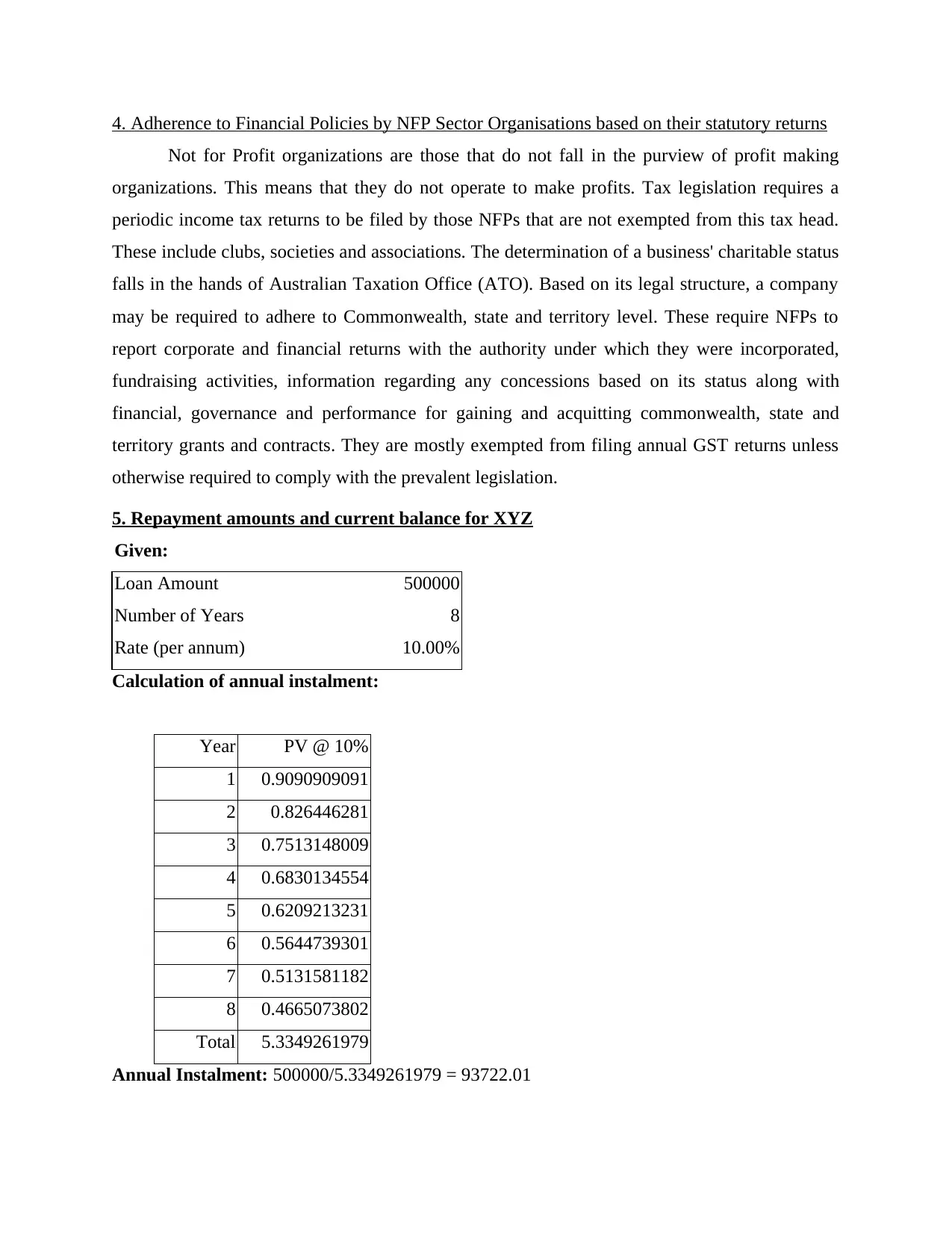
4. Adherence to Financial Policies by NFP Sector Organisations based on their statutory returns
Not for Profit organizations are those that do not fall in the purview of profit making
organizations. This means that they do not operate to make profits. Tax legislation requires a
periodic income tax returns to be filed by those NFPs that are not exempted from this tax head.
These include clubs, societies and associations. The determination of a business' charitable status
falls in the hands of Australian Taxation Office (ATO). Based on its legal structure, a company
may be required to adhere to Commonwealth, state and territory level. These require NFPs to
report corporate and financial returns with the authority under which they were incorporated,
fundraising activities, information regarding any concessions based on its status along with
financial, governance and performance for gaining and acquitting commonwealth, state and
territory grants and contracts. They are mostly exempted from filing annual GST returns unless
otherwise required to comply with the prevalent legislation.
5. Repayment amounts and current balance for XYZ
Given:
Loan Amount 500000
Number of Years 8
Rate (per annum) 10.00%
Calculation of annual instalment:
Year PV @ 10%
1 0.9090909091
2 0.826446281
3 0.7513148009
4 0.6830134554
5 0.6209213231
6 0.5644739301
7 0.5131581182
8 0.4665073802
Total 5.3349261979
Annual Instalment: 500000/5.3349261979 = 93722.01
Not for Profit organizations are those that do not fall in the purview of profit making
organizations. This means that they do not operate to make profits. Tax legislation requires a
periodic income tax returns to be filed by those NFPs that are not exempted from this tax head.
These include clubs, societies and associations. The determination of a business' charitable status
falls in the hands of Australian Taxation Office (ATO). Based on its legal structure, a company
may be required to adhere to Commonwealth, state and territory level. These require NFPs to
report corporate and financial returns with the authority under which they were incorporated,
fundraising activities, information regarding any concessions based on its status along with
financial, governance and performance for gaining and acquitting commonwealth, state and
territory grants and contracts. They are mostly exempted from filing annual GST returns unless
otherwise required to comply with the prevalent legislation.
5. Repayment amounts and current balance for XYZ
Given:
Loan Amount 500000
Number of Years 8
Rate (per annum) 10.00%
Calculation of annual instalment:
Year PV @ 10%
1 0.9090909091
2 0.826446281
3 0.7513148009
4 0.6830134554
5 0.6209213231
6 0.5644739301
7 0.5131581182
8 0.4665073802
Total 5.3349261979
Annual Instalment: 500000/5.3349261979 = 93722.01
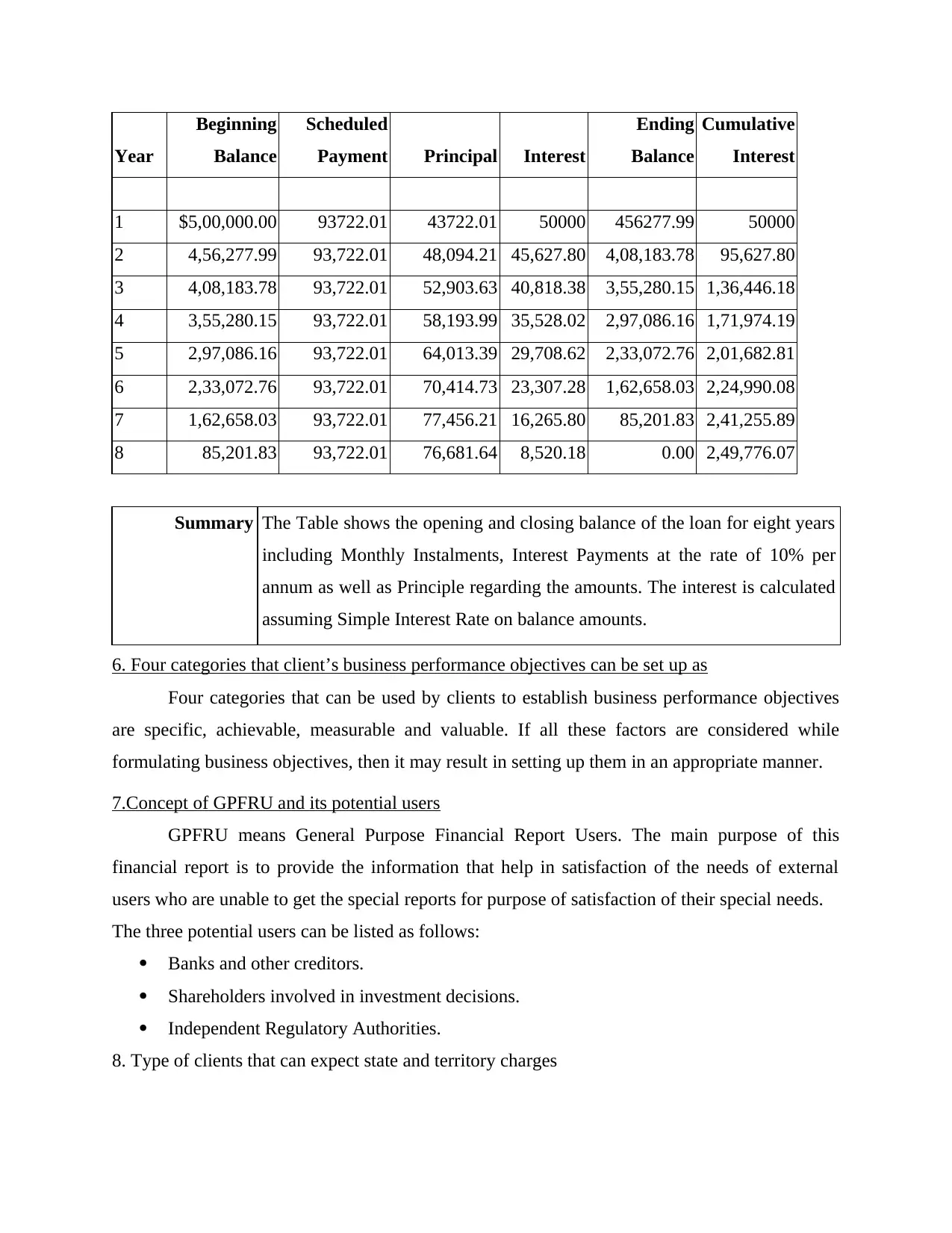
Year
Beginning
Balance
Scheduled
Payment Principal Interest
Ending
Balance
Cumulative
Interest
1 $5,00,000.00 93722.01 43722.01 50000 456277.99 50000
2 4,56,277.99 93,722.01 48,094.21 45,627.80 4,08,183.78 95,627.80
3 4,08,183.78 93,722.01 52,903.63 40,818.38 3,55,280.15 1,36,446.18
4 3,55,280.15 93,722.01 58,193.99 35,528.02 2,97,086.16 1,71,974.19
5 2,97,086.16 93,722.01 64,013.39 29,708.62 2,33,072.76 2,01,682.81
6 2,33,072.76 93,722.01 70,414.73 23,307.28 1,62,658.03 2,24,990.08
7 1,62,658.03 93,722.01 77,456.21 16,265.80 85,201.83 2,41,255.89
8 85,201.83 93,722.01 76,681.64 8,520.18 0.00 2,49,776.07
Summary The Table shows the opening and closing balance of the loan for eight years
including Monthly Instalments, Interest Payments at the rate of 10% per
annum as well as Principle regarding the amounts. The interest is calculated
assuming Simple Interest Rate on balance amounts.
6. Four categories that client’s business performance objectives can be set up as
Four categories that can be used by clients to establish business performance objectives
are specific, achievable, measurable and valuable. If all these factors are considered while
formulating business objectives, then it may result in setting up them in an appropriate manner.
7.Concept of GPFRU and its potential users
GPFRU means General Purpose Financial Report Users. The main purpose of this
financial report is to provide the information that help in satisfaction of the needs of external
users who are unable to get the special reports for purpose of satisfaction of their special needs.
The three potential users can be listed as follows:
Banks and other creditors.
Shareholders involved in investment decisions.
Independent Regulatory Authorities.
8. Type of clients that can expect state and territory charges
Beginning
Balance
Scheduled
Payment Principal Interest
Ending
Balance
Cumulative
Interest
1 $5,00,000.00 93722.01 43722.01 50000 456277.99 50000
2 4,56,277.99 93,722.01 48,094.21 45,627.80 4,08,183.78 95,627.80
3 4,08,183.78 93,722.01 52,903.63 40,818.38 3,55,280.15 1,36,446.18
4 3,55,280.15 93,722.01 58,193.99 35,528.02 2,97,086.16 1,71,974.19
5 2,97,086.16 93,722.01 64,013.39 29,708.62 2,33,072.76 2,01,682.81
6 2,33,072.76 93,722.01 70,414.73 23,307.28 1,62,658.03 2,24,990.08
7 1,62,658.03 93,722.01 77,456.21 16,265.80 85,201.83 2,41,255.89
8 85,201.83 93,722.01 76,681.64 8,520.18 0.00 2,49,776.07
Summary The Table shows the opening and closing balance of the loan for eight years
including Monthly Instalments, Interest Payments at the rate of 10% per
annum as well as Principle regarding the amounts. The interest is calculated
assuming Simple Interest Rate on balance amounts.
6. Four categories that client’s business performance objectives can be set up as
Four categories that can be used by clients to establish business performance objectives
are specific, achievable, measurable and valuable. If all these factors are considered while
formulating business objectives, then it may result in setting up them in an appropriate manner.
7.Concept of GPFRU and its potential users
GPFRU means General Purpose Financial Report Users. The main purpose of this
financial report is to provide the information that help in satisfaction of the needs of external
users who are unable to get the special reports for purpose of satisfaction of their special needs.
The three potential users can be listed as follows:
Banks and other creditors.
Shareholders involved in investment decisions.
Independent Regulatory Authorities.
8. Type of clients that can expect state and territory charges
⊘ This is a preview!⊘
Do you want full access?
Subscribe today to unlock all pages.

Trusted by 1+ million students worldwide
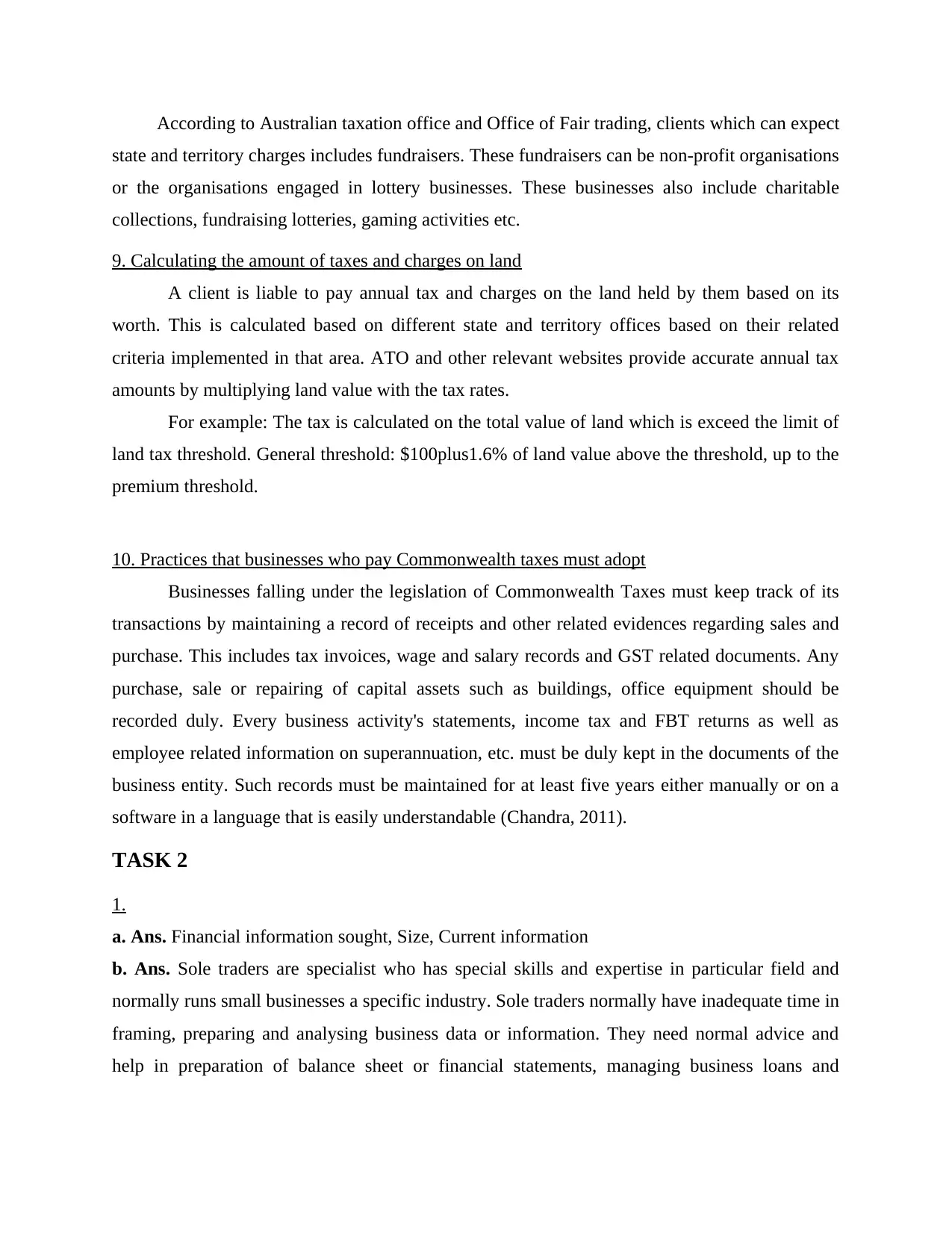
According to Australian taxation office and Office of Fair trading, clients which can expect
state and territory charges includes fundraisers. These fundraisers can be non-profit organisations
or the organisations engaged in lottery businesses. These businesses also include charitable
collections, fundraising lotteries, gaming activities etc.
9. Calculating the amount of taxes and charges on land
A client is liable to pay annual tax and charges on the land held by them based on its
worth. This is calculated based on different state and territory offices based on their related
criteria implemented in that area. ATO and other relevant websites provide accurate annual tax
amounts by multiplying land value with the tax rates.
For example: The tax is calculated on the total value of land which is exceed the limit of
land tax threshold. General threshold: $100plus1.6% of land value above the threshold, up to the
premium threshold.
10. Practices that businesses who pay Commonwealth taxes must adopt
Businesses falling under the legislation of Commonwealth Taxes must keep track of its
transactions by maintaining a record of receipts and other related evidences regarding sales and
purchase. This includes tax invoices, wage and salary records and GST related documents. Any
purchase, sale or repairing of capital assets such as buildings, office equipment should be
recorded duly. Every business activity's statements, income tax and FBT returns as well as
employee related information on superannuation, etc. must be duly kept in the documents of the
business entity. Such records must be maintained for at least five years either manually or on a
software in a language that is easily understandable (Chandra, 2011).
TASK 2
1.
a. Ans. Financial information sought, Size, Current information
b. Ans. Sole traders are specialist who has special skills and expertise in particular field and
normally runs small businesses a specific industry. Sole traders normally have inadequate time in
framing, preparing and analysing business data or information. They need normal advice and
help in preparation of balance sheet or financial statements, managing business loans and
state and territory charges includes fundraisers. These fundraisers can be non-profit organisations
or the organisations engaged in lottery businesses. These businesses also include charitable
collections, fundraising lotteries, gaming activities etc.
9. Calculating the amount of taxes and charges on land
A client is liable to pay annual tax and charges on the land held by them based on its
worth. This is calculated based on different state and territory offices based on their related
criteria implemented in that area. ATO and other relevant websites provide accurate annual tax
amounts by multiplying land value with the tax rates.
For example: The tax is calculated on the total value of land which is exceed the limit of
land tax threshold. General threshold: $100plus1.6% of land value above the threshold, up to the
premium threshold.
10. Practices that businesses who pay Commonwealth taxes must adopt
Businesses falling under the legislation of Commonwealth Taxes must keep track of its
transactions by maintaining a record of receipts and other related evidences regarding sales and
purchase. This includes tax invoices, wage and salary records and GST related documents. Any
purchase, sale or repairing of capital assets such as buildings, office equipment should be
recorded duly. Every business activity's statements, income tax and FBT returns as well as
employee related information on superannuation, etc. must be duly kept in the documents of the
business entity. Such records must be maintained for at least five years either manually or on a
software in a language that is easily understandable (Chandra, 2011).
TASK 2
1.
a. Ans. Financial information sought, Size, Current information
b. Ans. Sole traders are specialist who has special skills and expertise in particular field and
normally runs small businesses a specific industry. Sole traders normally have inadequate time in
framing, preparing and analysing business data or information. They need normal advice and
help in preparation of balance sheet or financial statements, managing business loans and
Paraphrase This Document
Need a fresh take? Get an instant paraphrase of this document with our AI Paraphraser
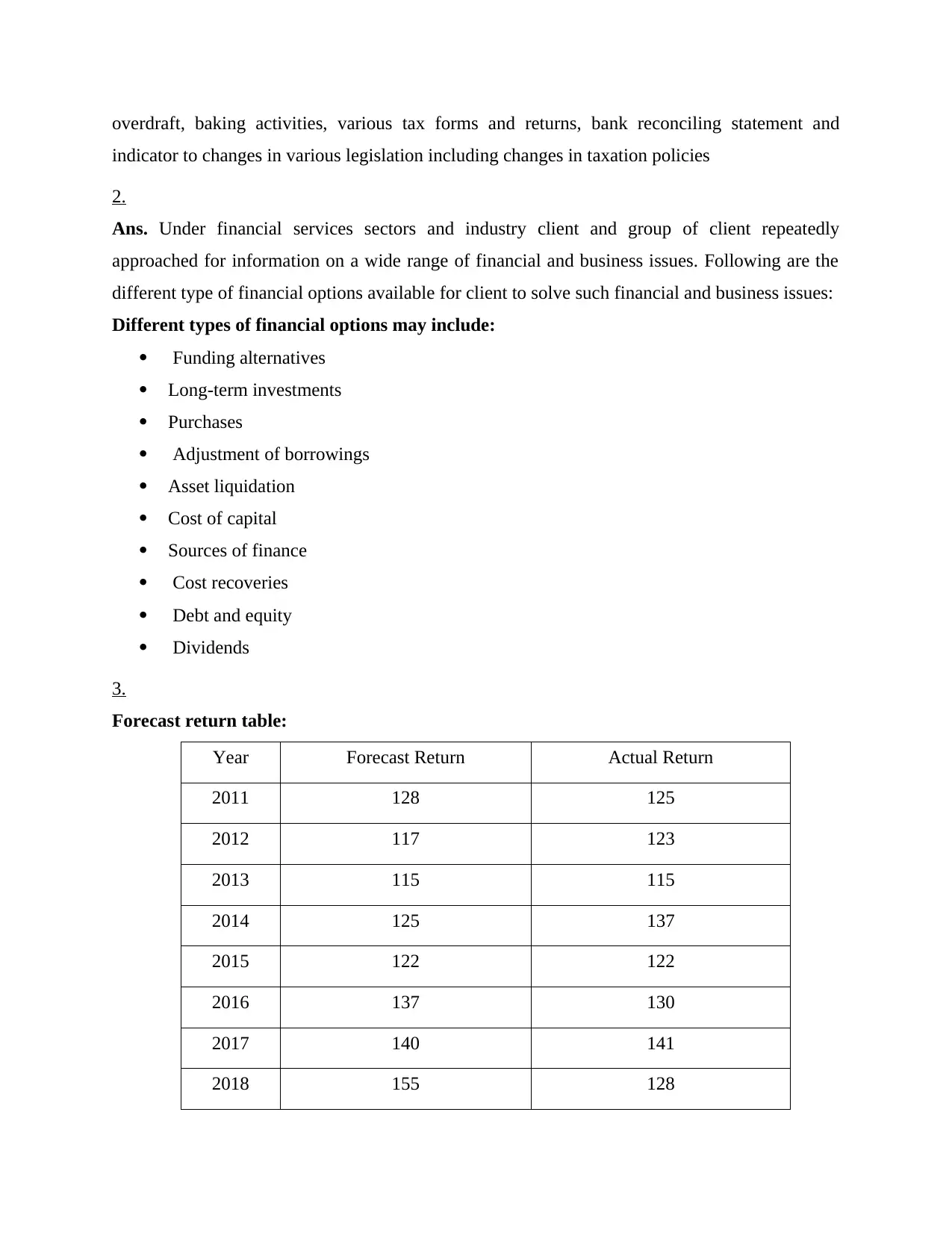
overdraft, baking activities, various tax forms and returns, bank reconciling statement and
indicator to changes in various legislation including changes in taxation policies
2.
Ans. Under financial services sectors and industry client and group of client repeatedly
approached for information on a wide range of financial and business issues. Following are the
different type of financial options available for client to solve such financial and business issues:
Different types of financial options may include:
Funding alternatives
Long-term investments
Purchases
Adjustment of borrowings
Asset liquidation
Cost of capital
Sources of finance
Cost recoveries
Debt and equity
Dividends
3.
Forecast return table:
Year Forecast Return Actual Return
2011 128 125
2012 117 123
2013 115 115
2014 125 137
2015 122 122
2016 137 130
2017 140 141
2018 155 128
indicator to changes in various legislation including changes in taxation policies
2.
Ans. Under financial services sectors and industry client and group of client repeatedly
approached for information on a wide range of financial and business issues. Following are the
different type of financial options available for client to solve such financial and business issues:
Different types of financial options may include:
Funding alternatives
Long-term investments
Purchases
Adjustment of borrowings
Asset liquidation
Cost of capital
Sources of finance
Cost recoveries
Debt and equity
Dividends
3.
Forecast return table:
Year Forecast Return Actual Return
2011 128 125
2012 117 123
2013 115 115
2014 125 137
2015 122 122
2016 137 130
2017 140 141
2018 155 128
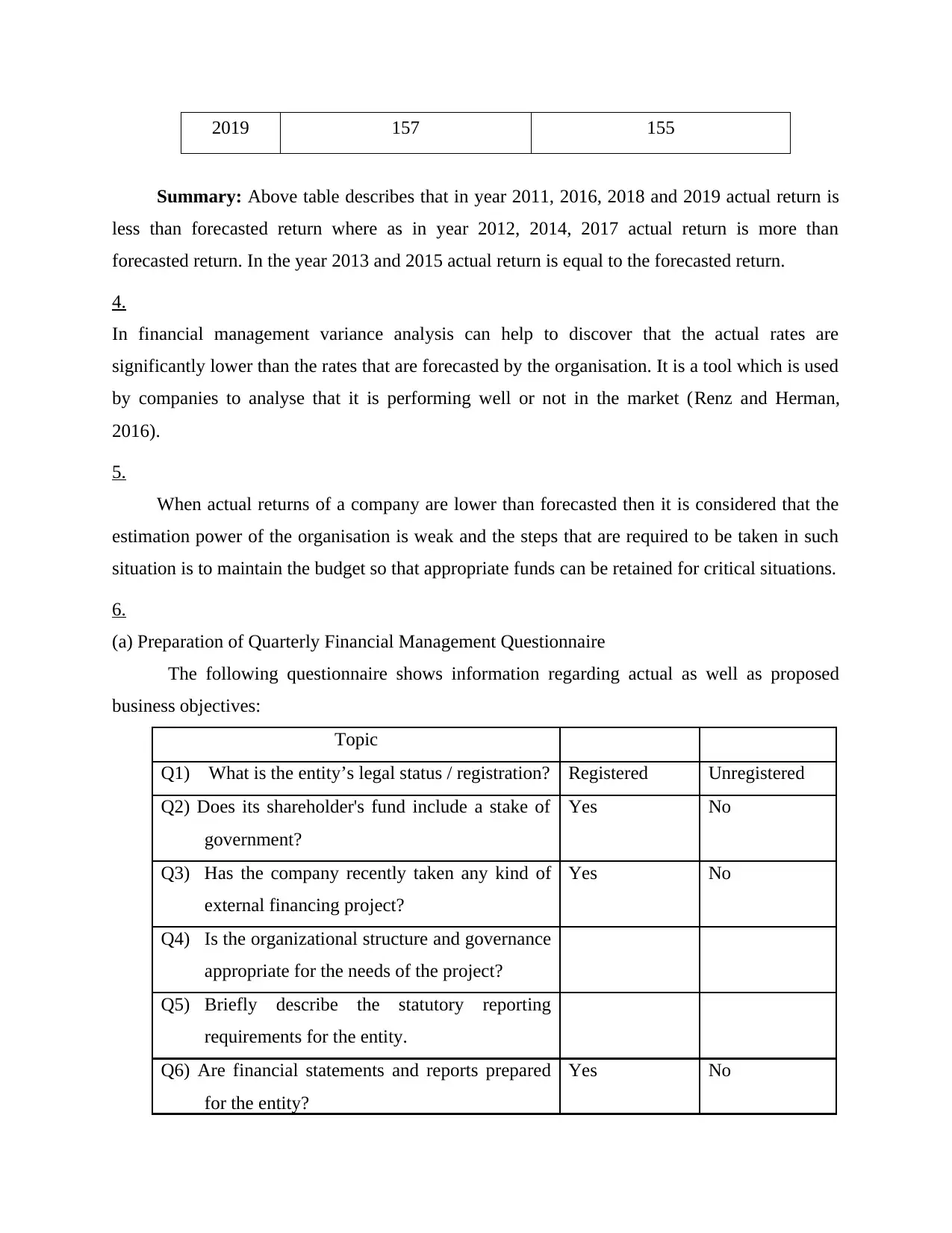
2019 157 155
Summary: Above table describes that in year 2011, 2016, 2018 and 2019 actual return is
less than forecasted return where as in year 2012, 2014, 2017 actual return is more than
forecasted return. In the year 2013 and 2015 actual return is equal to the forecasted return.
4.
In financial management variance analysis can help to discover that the actual rates are
significantly lower than the rates that are forecasted by the organisation. It is a tool which is used
by companies to analyse that it is performing well or not in the market (Renz and Herman,
2016).
5.
When actual returns of a company are lower than forecasted then it is considered that the
estimation power of the organisation is weak and the steps that are required to be taken in such
situation is to maintain the budget so that appropriate funds can be retained for critical situations.
6.
(a) Preparation of Quarterly Financial Management Questionnaire
The following questionnaire shows information regarding actual as well as proposed
business objectives:
Topic
Q1) What is the entity’s legal status / registration? Registered Unregistered
Q2) Does its shareholder's fund include a stake of
government?
Yes No
Q3) Has the company recently taken any kind of
external financing project?
Yes No
Q4) Is the organizational structure and governance
appropriate for the needs of the project?
Q5) Briefly describe the statutory reporting
requirements for the entity.
Q6) Are financial statements and reports prepared
for the entity?
Yes No
Summary: Above table describes that in year 2011, 2016, 2018 and 2019 actual return is
less than forecasted return where as in year 2012, 2014, 2017 actual return is more than
forecasted return. In the year 2013 and 2015 actual return is equal to the forecasted return.
4.
In financial management variance analysis can help to discover that the actual rates are
significantly lower than the rates that are forecasted by the organisation. It is a tool which is used
by companies to analyse that it is performing well or not in the market (Renz and Herman,
2016).
5.
When actual returns of a company are lower than forecasted then it is considered that the
estimation power of the organisation is weak and the steps that are required to be taken in such
situation is to maintain the budget so that appropriate funds can be retained for critical situations.
6.
(a) Preparation of Quarterly Financial Management Questionnaire
The following questionnaire shows information regarding actual as well as proposed
business objectives:
Topic
Q1) What is the entity’s legal status / registration? Registered Unregistered
Q2) Does its shareholder's fund include a stake of
government?
Yes No
Q3) Has the company recently taken any kind of
external financing project?
Yes No
Q4) Is the organizational structure and governance
appropriate for the needs of the project?
Q5) Briefly describe the statutory reporting
requirements for the entity.
Q6) Are financial statements and reports prepared
for the entity?
Yes No
⊘ This is a preview!⊘
Do you want full access?
Subscribe today to unlock all pages.

Trusted by 1+ million students worldwide
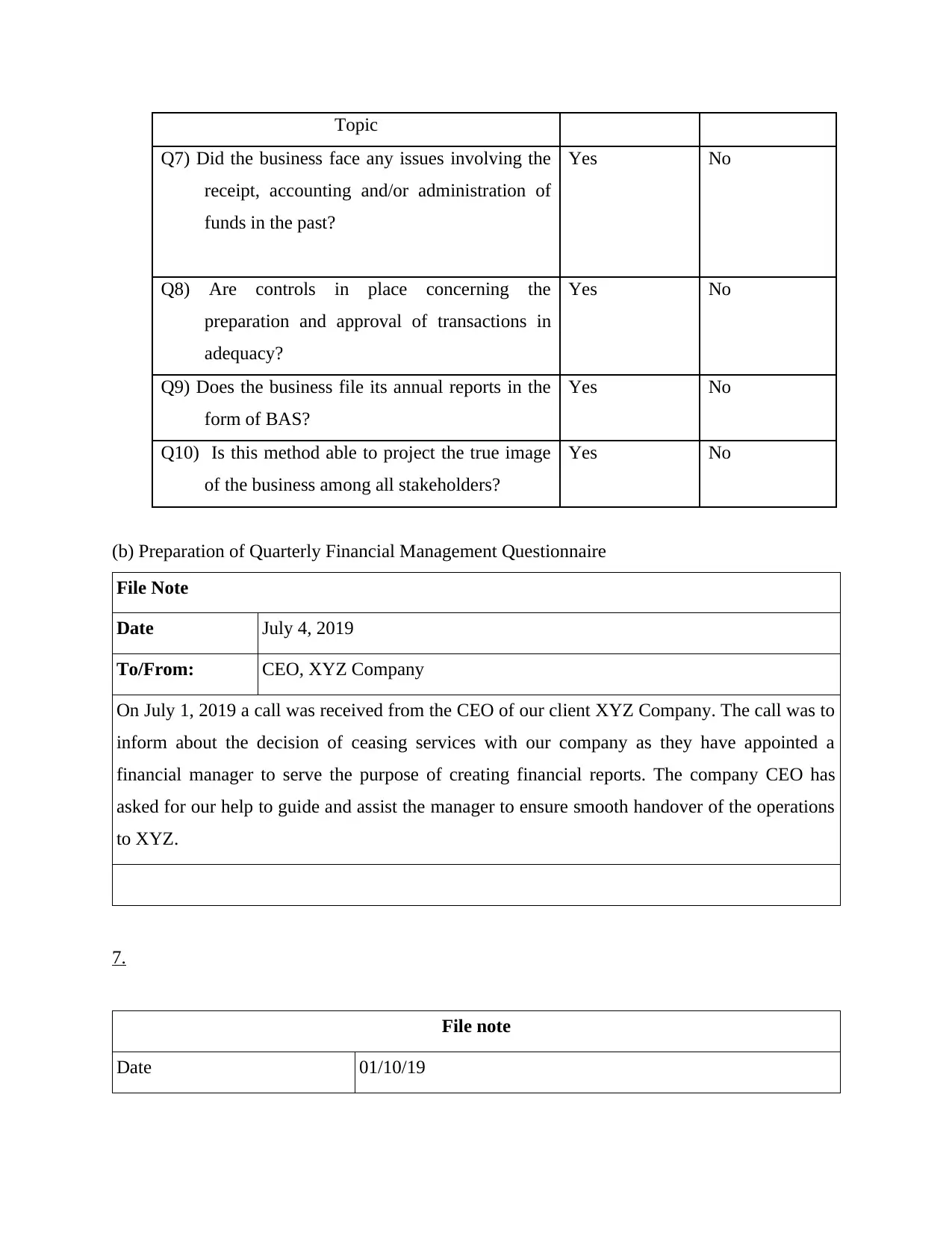
Topic
Q7) Did the business face any issues involving the
receipt, accounting and/or administration of
funds in the past?
Yes No
Q8) Are controls in place concerning the
preparation and approval of transactions in
adequacy?
Yes No
Q9) Does the business file its annual reports in the
form of BAS?
Yes No
Q10) Is this method able to project the true image
of the business among all stakeholders?
Yes No
(b) Preparation of Quarterly Financial Management Questionnaire
File Note
Date July 4, 2019
To/From: CEO, XYZ Company
On July 1, 2019 a call was received from the CEO of our client XYZ Company. The call was to
inform about the decision of ceasing services with our company as they have appointed a
financial manager to serve the purpose of creating financial reports. The company CEO has
asked for our help to guide and assist the manager to ensure smooth handover of the operations
to XYZ.
7.
File note
Date 01/10/19
Q7) Did the business face any issues involving the
receipt, accounting and/or administration of
funds in the past?
Yes No
Q8) Are controls in place concerning the
preparation and approval of transactions in
adequacy?
Yes No
Q9) Does the business file its annual reports in the
form of BAS?
Yes No
Q10) Is this method able to project the true image
of the business among all stakeholders?
Yes No
(b) Preparation of Quarterly Financial Management Questionnaire
File Note
Date July 4, 2019
To/From: CEO, XYZ Company
On July 1, 2019 a call was received from the CEO of our client XYZ Company. The call was to
inform about the decision of ceasing services with our company as they have appointed a
financial manager to serve the purpose of creating financial reports. The company CEO has
asked for our help to guide and assist the manager to ensure smooth handover of the operations
to XYZ.
7.
File note
Date 01/10/19
Paraphrase This Document
Need a fresh take? Get an instant paraphrase of this document with our AI Paraphraser
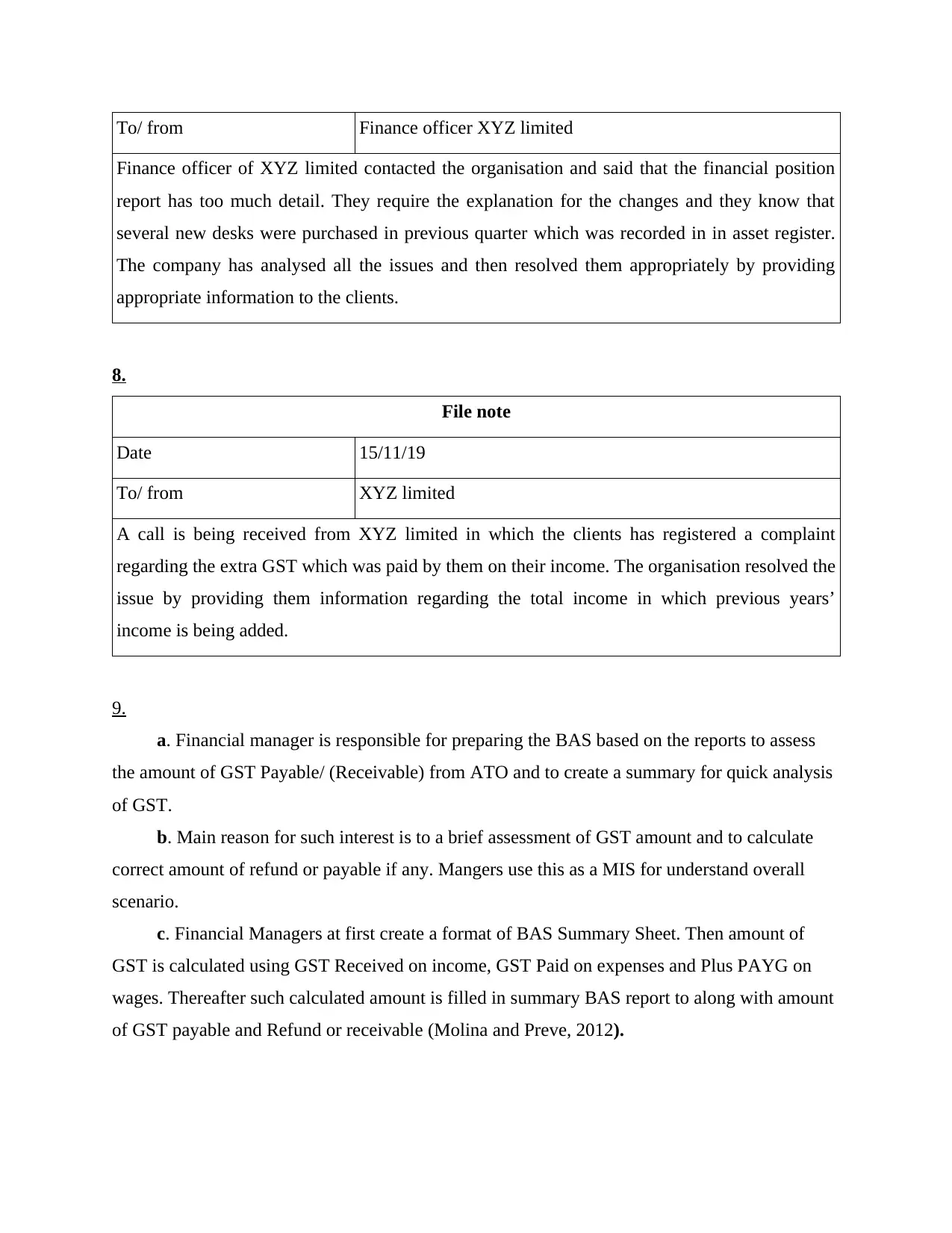
To/ from Finance officer XYZ limited
Finance officer of XYZ limited contacted the organisation and said that the financial position
report has too much detail. They require the explanation for the changes and they know that
several new desks were purchased in previous quarter which was recorded in in asset register.
The company has analysed all the issues and then resolved them appropriately by providing
appropriate information to the clients.
8.
File note
Date 15/11/19
To/ from XYZ limited
A call is being received from XYZ limited in which the clients has registered a complaint
regarding the extra GST which was paid by them on their income. The organisation resolved the
issue by providing them information regarding the total income in which previous years’
income is being added.
9.
a. Financial manager is responsible for preparing the BAS based on the reports to assess
the amount of GST Payable/ (Receivable) from ATO and to create a summary for quick analysis
of GST.
b. Main reason for such interest is to a brief assessment of GST amount and to calculate
correct amount of refund or payable if any. Mangers use this as a MIS for understand overall
scenario.
c. Financial Managers at first create a format of BAS Summary Sheet. Then amount of
GST is calculated using GST Received on income, GST Paid on expenses and Plus PAYG on
wages. Thereafter such calculated amount is filled in summary BAS report to along with amount
of GST payable and Refund or receivable (Molina and Preve, 2012).
Finance officer of XYZ limited contacted the organisation and said that the financial position
report has too much detail. They require the explanation for the changes and they know that
several new desks were purchased in previous quarter which was recorded in in asset register.
The company has analysed all the issues and then resolved them appropriately by providing
appropriate information to the clients.
8.
File note
Date 15/11/19
To/ from XYZ limited
A call is being received from XYZ limited in which the clients has registered a complaint
regarding the extra GST which was paid by them on their income. The organisation resolved the
issue by providing them information regarding the total income in which previous years’
income is being added.
9.
a. Financial manager is responsible for preparing the BAS based on the reports to assess
the amount of GST Payable/ (Receivable) from ATO and to create a summary for quick analysis
of GST.
b. Main reason for such interest is to a brief assessment of GST amount and to calculate
correct amount of refund or payable if any. Mangers use this as a MIS for understand overall
scenario.
c. Financial Managers at first create a format of BAS Summary Sheet. Then amount of
GST is calculated using GST Received on income, GST Paid on expenses and Plus PAYG on
wages. Thereafter such calculated amount is filled in summary BAS report to along with amount
of GST payable and Refund or receivable (Molina and Preve, 2012).
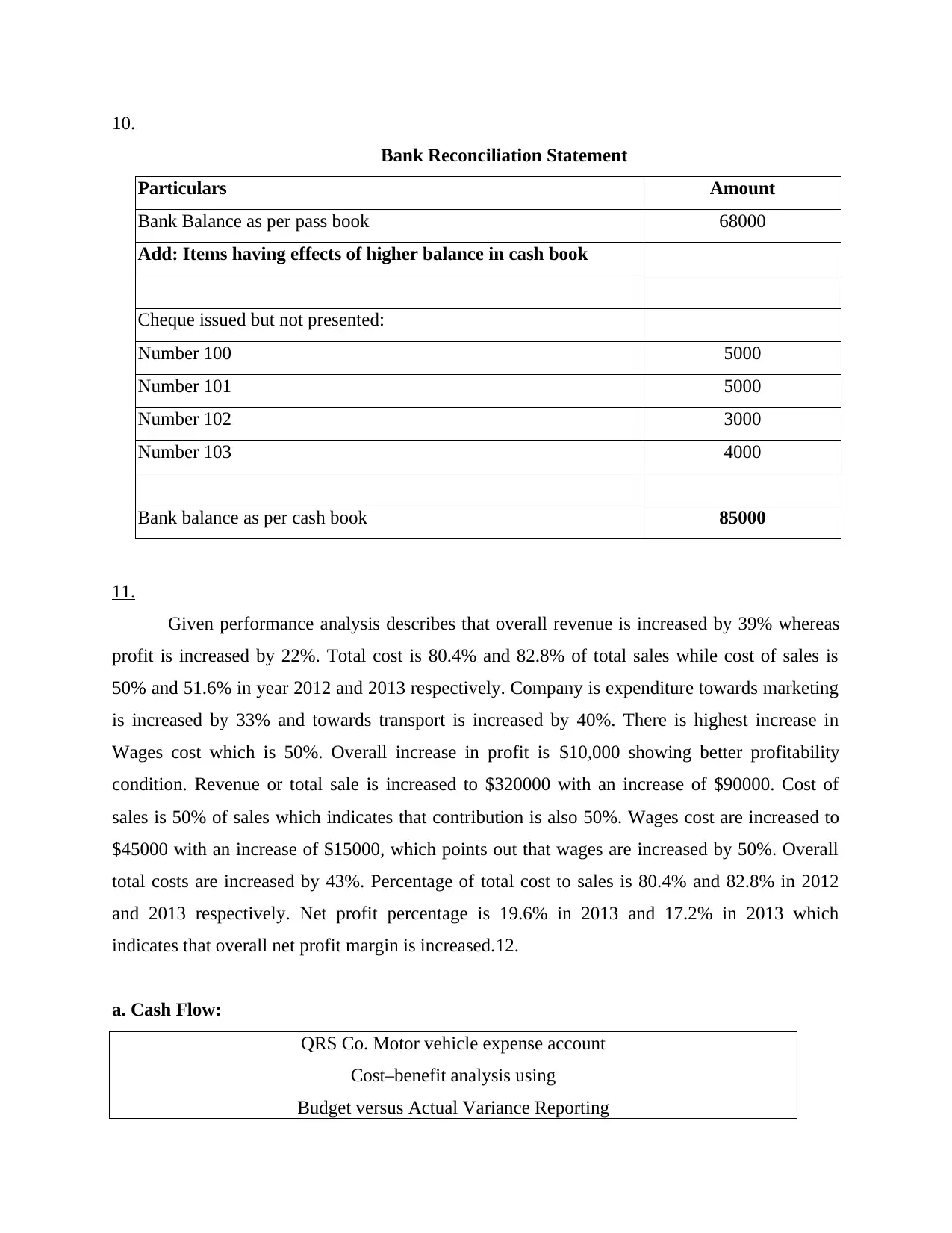
10.
Bank Reconciliation Statement
Particulars Amount
Bank Balance as per pass book 68000
Add: Items having effects of higher balance in cash book
Cheque issued but not presented:
Number 100 5000
Number 101 5000
Number 102 3000
Number 103 4000
Bank balance as per cash book 85000
11.
Given performance analysis describes that overall revenue is increased by 39% whereas
profit is increased by 22%. Total cost is 80.4% and 82.8% of total sales while cost of sales is
50% and 51.6% in year 2012 and 2013 respectively. Company is expenditure towards marketing
is increased by 33% and towards transport is increased by 40%. There is highest increase in
Wages cost which is 50%. Overall increase in profit is $10,000 showing better profitability
condition. Revenue or total sale is increased to $320000 with an increase of $90000. Cost of
sales is 50% of sales which indicates that contribution is also 50%. Wages cost are increased to
$45000 with an increase of $15000, which points out that wages are increased by 50%. Overall
total costs are increased by 43%. Percentage of total cost to sales is 80.4% and 82.8% in 2012
and 2013 respectively. Net profit percentage is 19.6% in 2013 and 17.2% in 2013 which
indicates that overall net profit margin is increased.12.
a. Cash Flow:
QRS Co. Motor vehicle expense account
Cost–benefit analysis using
Budget versus Actual Variance Reporting
Bank Reconciliation Statement
Particulars Amount
Bank Balance as per pass book 68000
Add: Items having effects of higher balance in cash book
Cheque issued but not presented:
Number 100 5000
Number 101 5000
Number 102 3000
Number 103 4000
Bank balance as per cash book 85000
11.
Given performance analysis describes that overall revenue is increased by 39% whereas
profit is increased by 22%. Total cost is 80.4% and 82.8% of total sales while cost of sales is
50% and 51.6% in year 2012 and 2013 respectively. Company is expenditure towards marketing
is increased by 33% and towards transport is increased by 40%. There is highest increase in
Wages cost which is 50%. Overall increase in profit is $10,000 showing better profitability
condition. Revenue or total sale is increased to $320000 with an increase of $90000. Cost of
sales is 50% of sales which indicates that contribution is also 50%. Wages cost are increased to
$45000 with an increase of $15000, which points out that wages are increased by 50%. Overall
total costs are increased by 43%. Percentage of total cost to sales is 80.4% and 82.8% in 2012
and 2013 respectively. Net profit percentage is 19.6% in 2013 and 17.2% in 2013 which
indicates that overall net profit margin is increased.12.
a. Cash Flow:
QRS Co. Motor vehicle expense account
Cost–benefit analysis using
Budget versus Actual Variance Reporting
⊘ This is a preview!⊘
Do you want full access?
Subscribe today to unlock all pages.

Trusted by 1+ million students worldwide
1 out of 17
Related Documents
Your All-in-One AI-Powered Toolkit for Academic Success.
+13062052269
info@desklib.com
Available 24*7 on WhatsApp / Email
![[object Object]](/_next/static/media/star-bottom.7253800d.svg)
Unlock your academic potential
Copyright © 2020–2025 A2Z Services. All Rights Reserved. Developed and managed by ZUCOL.




